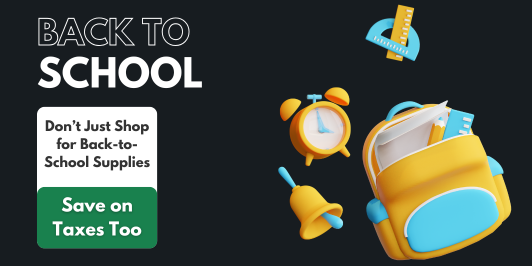The school year is starting, and while you’re buying backpacks and supplies, don’t forget about the hidden tax perks.
Back-to-School Tax Savings
Here’s how to make the most of back-to-school season financially considering the latest tax rules and credits under the One Big Beautiful Bill Act (OBBBA).
1. Educator Expense Deduction Still Counts
Teachers and eligible school staff can deduct up to $300 for unreimbursed classroom supplies. Married educators filing jointly may claim up to $600. You don’t need to itemize to claim the educator expense deduction either. The educator expense deduction is considered an “above-the-line” deduction, meaning it’s subtracted from your gross income to arrive at your adjusted gross income (AGI).
Teachers may be eligible for the Educator Expense Deduction if they meet certain criteria. You must:
- work as a teacher, instructor, counselor, principal or classroom aide,
- work with students in kindergarten through grade 12,
- complete at least 900 hours of work during the school year, and
- be employed by a school that provides elementary or secondary education as determined by state law.
However, individuals working at pre-schools, homeschooling their own children, or who are employed by a college or graduate school would not qualify for this deduction.
2. Child and Dependent Care Credit
If you’re paying for after-school care, summer day camps, or daycare for children under age 13, you may qualify for a tax credit of up to 35% of eligible expenses.
To claim the credit, you (and your spouse, if you’re married) must have income earned from a job and you must have paid for the care so that you could work or look for work. Also, you can claim from 20% to 35% of your care expenses up to a maximum of $3,000 for one person, or $6,000 for two or more people (tax year 2024).
Tip: Plan ahead and save receipts and provider information for IRS Form 2441.
3. Sales Tax Holidays & State Credits
Many states offer back-to-school sales tax holidays that exempt items like:
- Clothing,
- School supplies, and
- Technology (e.g., laptops, tablets).
Additionally, some states have introduced refundable tax credits for private school tuition and homeschooling expenses. Remember, there is no for federal tax deduction, but it’s possible that you may be able to claim other tax breaks for funding your child’s education.
4. NEW for 2025: OBBBA Education-Related Back-to-School Benefits
The One Big Beautiful Bill Act (OBBBA), signed into law in July 2025, introduced several tax-related updates relevant for back-to-school season:
- Trump Accounts for Newborns: If your child was born in 2025, you’ll receive a $1,000 federal deposit into a dedicated education savings account. You can contribute an additional $5,000 annually. These funds can eventually be used for K–12 tuition, college, vocational training, or even homeownership.
- Private School Credit: If you donate to a state-approved Scholarship Granting Organization (SGO), you may now claim a federal tax credit matching the donation amount dollar-for-dollar—making it easier to support private education.
- Enhanced Child Tax Credit: The credit was raised to $2,200 per child in 2025, with larger refundable portions. This helps cover early childhood and school-year expenses.
Example: A parent who donates $2,000 to a qualifying SGO could reduce their federal tax bill by $2,000 and potentially earn a state credit.
5. Track School-Related Expenses All Year
Whether you’re buying software for your student or paying tutoring fees, good record-keeping pays off. Some expenses may not be deductible now but could support future education credits.
Perfect Time to Make Smart Tax Moves
Back-to-school isn’t just about new clothes and supplies—it’s also a perfect time to make smart tax moves. Between federal credits, state incentives, and OBBBA-backed programs, there’s an opportunity to support your child’s education and reduce your tax liability.
What is the SGO Credit under OBBBA?
Under the One Big Beautiful Bill Act (OBBBA), effective in 2025:
- Donors to state-recognized SGOs may receive a federal, dollar-for-dollar income tax credit for their donation.
- This is different from a deduction—you get a direct reduction in your tax liability equal to your contribution amount (up to the cap set by the IRS or your state).
- Many states also offer their own separate state-level SGO credits, meaning you might receive both federal and state tax benefits.
Example:
If you donate $2,000 to a qualifying SGO:
- You may reduce your federal income tax bill by $2,000
- And potentially receive a state tax credit or deduction, depending on your state’s laws
Why It Matters for Education
This credit is designed to increase access to private education by encouraging individuals and businesses to support K–12 scholarships. It’s one of the most generous education-related tax benefits currently available.
Get ahead of school-year spending with a tax-smart strategy. Contact our team to schedule a personalized education tax review.
